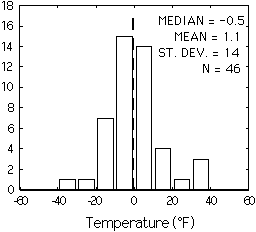Simple correction | Gulf of Mexico correction | Last Resort Correction | BHT Home page | ZetaWare Home
Log-header bottom hole temperature (BHT) data
are notoriously unreliable. However, due to the general lack of better quality
data, BHT data must often be used to constrain the subsurface thermal regime.
Dr. Jeff Corrigan analyzed 983 bottom hole temperature (BHT) and associated
equilibrium temperatures estimate (Teq) pairs. Based on his analysis, methods
for correcting BHT data are recommended using information typically available
with BHT data (the BHT measurement, time since circulation, and/or depth).
The recommended BHT correction method depends on the type of information available. A Horner correction is recommended if three of more self-consistent BHTs from a given depth are available. For data in Dr. Corrigan's study, the Teq estimate uncertainty (1 sigma) using the Horner correction is ±14 °F (±8 °C)
|
|
Note. Your browser may block the calculations. You will need to allow
blocked content if the buttons do not seem to do anything. For a better experience,
we recommend using Chrome or Firefox.
Temperature can be in Fahrenheit or Celsius. If you do not have circulation time information, enter 1 hour to obtain a minimum Horner correction. The histogram below shows the differences between DST temperatures and adjacent ±500 ft. Horner-corrected BHTs. It provides an estimate of the uncertainty associated with a Horner-corrected temperature.
 | |||||||||||||||||
- Corrigan, J., 1997, Correcting bottom hole temperature data, AEPT Research Memo RM 97-0007.
- Horner, D. R., 1951. Pressure build-up in wells, Proc. Third World Petroleum Congress, 34, 316, The Hague.
- Chiang, C.T. and Carl R.Y. Chang, Application of the Horner Method to the estimation of static reservoir temperature during drilling operations. Taiwan Petroleum Corporation, Miaoli, Taiwan 360.
Copyright ©2003-2017, ZetaWare, Inc. All rights reserved